Dairy growth looks steady

TASMANIA’S dairy industry has seen a significant jump in production again this year despite challenging seasonal conditions.
Milk production for 2023-2024 increased by 3.1 per cent across the industry.
Overall, Tasmania produced 934.3 million litres last season despite very dry conditions across much of the state’s dairying region.
Tasmania lags behind the country’s second largest milk producing state New South Wales by just 1.2 per cent after production in that region increased by 5.1 per cent last year. Overall, Australian milk production also increased by 3.1 per cent last year.
Dairy farmers across the country produced 8.37 billion litres, an increase of 249 million litres.
In its new Global Dairy Quarterly report, Rabobank said, despite the increase, the bank is expecting Australian production to grow at a lower rate in the 2024-2025 season – currently forecast at 1.5 per cent.
RaboResearch senior dairy analyst Michael Harvey says Australian milk supply growth has been widespread, with production expanding in all states and regions, with the exception of western Victoria where dry conditions have constrained production.
“Seasonal conditions remain mixed though across the key dairying regions,” Mr Harvey said.
“There have been severe rainfall deficiencies so far in 2024 for western Victoria and South Australia, which are sizeable milk production regions.
However seasonal conditions elsewhere have been mostly favourable.”
The report says the global dairy market remains balanced, but sensitive to change and the next year could see significant shifts as production increases and markets adjust.
Milk production from the main global export regions had been elusive over recent years, Mr Harvey said.
“Since the second half of 2021, combined milk production from the Big-7 dairy export regions – the EU, US, New Zealand, Australia, Brazil, Argentina and Uruguay – has only grown in three quarters,” he said.
However, high dairy prices in the first half of 2024, plus lower feed costs, have improved farmer margins, encouraging production.
RaboResearch expects milk supply from the major exporting regions to increase a modest 0.14 per cent in 2024 on the previous year.
“With producers seeing improved margins though, milk supply could make a distinct shift upward in 2025,” Mr Harvey said.
“Our initial forecasts for 2025 suggest a 0.65 per cent year-on-year production lift from the Big 7, bringing global milk supply from these regions above the five-year average.”
Demand for dairy remains mixed across regions, the report says.
“At a retail level, price deflation continues to occur within supermarket aisles in South America, the United States and in most of the EU,” Mr Harvey said.
“In response to weak consumer spending in food service channels, companies are spending more on promotions and advertising as consumers ‘pinch pennies’.”
Both demand for and production of milk are expected to decline in China, the world’s largest dairy importer.
Mr Harvey said RaboResearch had revised down its estimates for Chinese dairy consumption for 2024.
There have been no major changes to Australian farmgate milk prices since the new season announcements were made.
As a result of the easing farmgate milk prices, dairy farmers in affected regions are bracing for a margin squeeze, the report said, with softer cull cow prices and a drop in heifer export volumes adding to the margin pressure for some.
In terms of dairy producers’ costs, Mr Harvey said, there is a mixed outlook.
“Grain prices have drifted lower, which is welcome news for dairy farmers, and the outlook for prices for the current Australian winter crop is mostly favourable for purchasers.
But in stark contrast, fodder (hay) prices have jumped, driven by supply concerns,” he said.




Add new comment